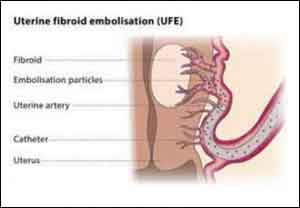- Home
- Editorial
- News
- Practice Guidelines
- Anesthesiology Guidelines
- Cancer Guidelines
- Cardiac Sciences Guidelines
- Critical Care Guidelines
- Dentistry Guidelines
- Dermatology Guidelines
- Diabetes and Endo Guidelines
- Diagnostics Guidelines
- ENT Guidelines
- Featured Practice Guidelines
- Gastroenterology Guidelines
- Geriatrics Guidelines
- Medicine Guidelines
- Nephrology Guidelines
- Neurosciences Guidelines
- Obs and Gynae Guidelines
- Ophthalmology Guidelines
- Orthopaedics Guidelines
- Paediatrics Guidelines
- Psychiatry Guidelines
- Pulmonology Guidelines
- Radiology Guidelines
- Surgery Guidelines
- Urology Guidelines
Three new treatment options for uterine Fibroids

Surgery is recommended for Uterine fibroids if the symptoms include an enlarged uterus or dramatic pressure on the bladder and rectum in addition to usual symptoms of long and heavy menstrual flow, pain and uncomfortable intercourse. But , the gynecologist may recommend surgery.UH Cleveland Medical Center is at the forefront of exploring new treatments for uterine fibroids. The following treatment options, if proven effective, could change the current standard of care by giving doctors more ways to shrink fibroids and eliminate symptoms, such as pain and bleeding.
“The surgical approach would be a laparoscopic, robotic or open procedure to remove the uterus,” explained James H. Liu, MD, Chair of the Department of Obstetrics and Gynecology at University Hospitals Cleveland Medical Center.
As a leader in clinical research, UH Cleveland Medical Center is at the forefront of exploring new treatments for uterine fibroids. The following treatment options, if proven effective, could change the current standard of care by giving doctors more ways to shrink fibroids and eliminate symptoms, such as pain and bleeding.
Elagolix and Ulipristal drug studies
Clinical investigators in the Department of Obstetrics & Gynecology at UH Cleveland Medical Center have led several drug trials focused on treating uterine fibroids.
Elagolix, an orally administered drug developed by AbbVie and Neurocrine Biosciences, demonstrated promise as a uterine fibroid treatment in a previous Phase II trial. UH Cleveland Medical Center is participating as a site for the Phase III trial, which is currently underway.
The drug is a GnRH antagonist that shuts down estrogen production by targeting the pituitary gland. Because estrogen stimulates growth of uterine fibroids, by reducing estrogen levels, this treatment can significantly shrink fibroids.
“This drug could be a transitional therapy for fibroids,” Dr. Liu said. “The treatment could help shrink the fibroids to help a woman become ready for a more conservative approach such as expectant management or surgery to remove the fibroid.”
UH Cleveland Medical Center is also a participating site in the VENUS II study, the second U.S. Phase III study of the drug ulipristal acetate to treat uterine fibroids. Ulipristal is available at a higher dose as a morning-after pill in the United States, and it is already approved for use in Canada and Europe as a treatment for uterine bleeding associated with fibroids. It works by controlling the levels of progesterone in the body.
“So many people have had a positive response with ulipristal,” Dr. Liu noted. “The data is starting to come out that suggests this drug could be an alternative to more conservative surgery.”
Dr. Liu and colleague Karen Ashby, MD, an obstetrician-gynecologist at UH Cleveland Medical Center, are both serving as investigators for the VENUS II study.
“We are hoping ulipristal is an option for women with fibroids,” Dr. Ashby said. “If we have a medication to control bleeding, reduce symptoms and improve quality of life – that is worth exploring.”
Guided high-intensity focused ultrasound (HIFU)
Dr. Liu also sees promise in a third new treatment: fibroid targeting using guided high-intensity focused ultrasound (HIFU). This is a more refined approach compared to uterine artery embolization.
“HIFU starves individual fibroids of their blood supply,” he said. “This technique targets the fibroid and nothing else, rather than embolization, which deprives the entire uterus of blood.” Depriving the entire uterus of blood will kill fibroids, but part of the uterus will also die.
UH has plans to participate in a study of HIFU, though it is not yet begun.
Ulipristal is the treatment closest to being approved for use in the United States, Dr. Liu noted, but data for the other two fibroid treatments are promising for women whose lives are disrupted by symptoms.
“These options will be a game changer compared to what is currently available,” he said.

Disclaimer: This site is primarily intended for healthcare professionals. Any content/information on this website does not replace the advice of medical and/or health professionals and should not be construed as medical/diagnostic advice/endorsement or prescription. Use of this site is subject to our terms of use, privacy policy, advertisement policy. © 2020 Minerva Medical Treatment Pvt Ltd